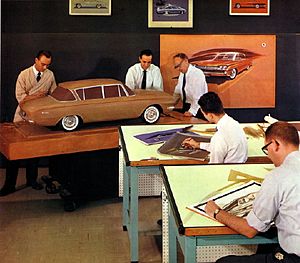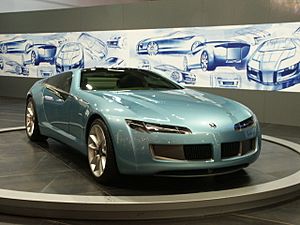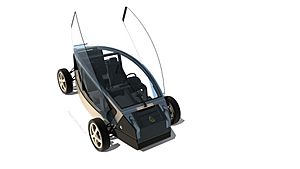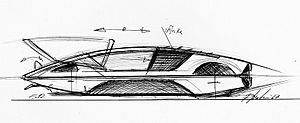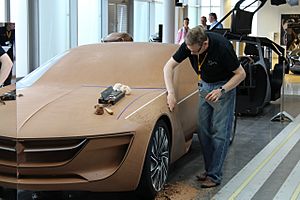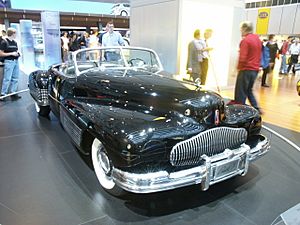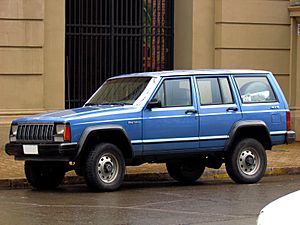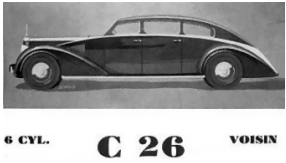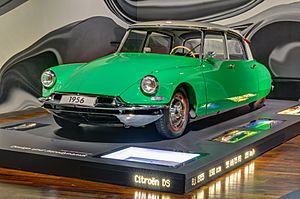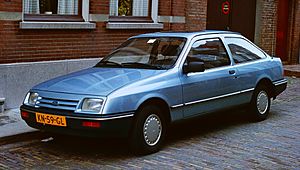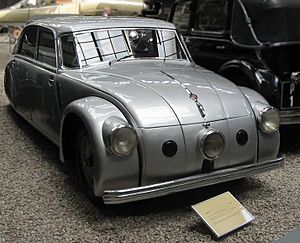Automotive design facts for kids
Automotive design is all about creating the look and feel of vehicles like cars, motorcycles, trucks, and buses. It's not just about making them look cool; it's also about making them comfortable and easy to use.
While engineers focus on how a car works, automotive designers focus on its visual style. They imagine new car ideas and bring them to life. These designers often study art or industrial design to learn their craft.
What Makes Up Car Design?
Designing a car involves a team working on different parts. The main areas are:
- Exterior design (the outside look)
- Interior design (the inside cabin)
- Color and trim design (the colors and materials)
Designers don't just focus on one part. They make sure the car's shape and features work well together. They also think about new car gadgets like GPS or smartphone connections. These new technologies can change how future car models look and feel.
Designing the Outside of a Car
The exterior design team shapes the car's overall look. They start with hand sketches and digital drawings. As ideas get approved, they create more detailed digital images.
They often ask for feedback from potential buyers. This helps them make sure the car appeals to the right people. After many changes, they build models out of clay or use digital 3D models.
These models help them see the car in real life. Even with advanced computer programs, clay models are still very important. They help designers check the final look of the car.
Designing the Inside of a Car
The interior design team focuses on the car's cabin. They decide the shape and placement of the dashboard, seats, and door panels. Their main goal is to make the car comfortable and easy for passengers to use.
They follow a similar process to exterior designers. They use sketches, digital models, and clay models to perfect the interior.
Choosing Colors and Materials
The color and trim team picks all the colors and materials for a car. This includes the paint, plastics, fabrics, and even wood trim. They carefully combine colors, textures, and patterns. This creates a unique feeling inside the car.
These designers get ideas from fashion, home decor, and architecture. They also research future trends to design cars that will be popular years from now.
Creating Car Graphics
The design team also creates graphics for the car. This includes things like badges, stickers, and the look of the dials on the dashboard.
Using Computers in Design
Designers use special computer programs to turn sketches into 3D models. These models help them see how the car will look in real time. As the design gets closer to being finished, the 3D model becomes very detailed. This helps engineers prepare the car for manufacturing.
Specialized software like Autodesk Alias and ICEM Surf are widely used. These programs help create very smooth and precise surfaces for the car's body.
How Cars Are Designed
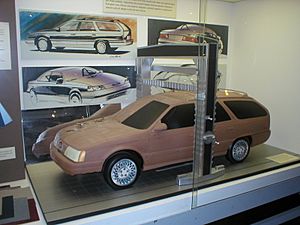
Car companies have slightly different ways of designing cars. But generally, the process includes these steps:
- Research: Finding out what customers want.
- Concept Sketching: Drawing initial ideas.
- Computer Modeling: Creating 3D digital models.
- Clay Modeling: Building physical models out of clay.
- Interior Mock-up: Creating a model of the car's inside.
- Ergonomics: Making sure the car is comfortable and easy to use.
- Surface Development: Refining the car's surfaces for manufacturing.
- Color and Trim: Choosing colors and materials.
- Graphics: Designing badges and other visual elements.
Designers work closely with engineers throughout this process. Engineers make sure the design can be built safely and efficiently. This teamwork leads to the final car ready for production.
The Design Team
A design team for one car model usually has a chief designer. There are also separate designers for the exterior and interior. Junior designers help with specific parts. The color and trim designer works with everyone.
Clay modelers and digital modelers also work closely with the design team. The whole team, including studio managers and engineers, can be 25 to 40 people. It takes over two years to design a full car before it's ready for factories.
A Look Back at Car Design
Car Design in the United States
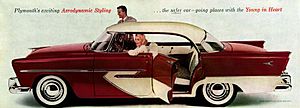
In the 1920s, American car design changed a lot. General Motors leader Alfred P. Sloan Jr. started changing car designs every year. This was to encourage people to buy new cars often. Some called this "planned obsolescence," meaning things were designed to become old quickly.
Smaller car companies found it hard to keep up with these yearly changes. Henry Ford didn't like this idea, but GM became the top car company.
Designers like Gordon Buehrig created famous cars like the Auburn 851. In the 1930s, Chrysler tried new aerodynamic designs with the Chrysler Airflow. It was very advanced, but people didn't like its look at first. This taught the industry to be careful with very new designs.
Harley Earl greatly influenced American car styling. He introduced the tailfin on cars like the 1948 Cadillac. Another important designer was Virgil Exner at Chrysler. He created the "Forward Look" design in the 1950s. He also used wind tunnels to make cars more aerodynamic, inspired by rockets.
In the 1960s, Dick Teague at American Motors Corporation (AMC) came up with a clever idea. He used interchangeable body parts to create many different cars from the same basic pieces. He designed unique cars like the AMC AMX, Gremlin, and the original Jeep Cherokee (XJ).
Also in the 1960s, Ford launched the first Ford Mustang. It sold incredibly well and created a whole new type of car called the "pony car."
Car Design in Europe
Before World War I, carmakers focused on making cars reliable. Later, luxury and good looks became important for selling cars. Each country in Europe developed its own unique car design style. World War II slowed things down, but by the 1950s, Italian designers were leading the way.
France
In France, Bugatti and Avions Voisin made notable designs. Citroën launched cars with very new designs and engineering, often helped by designer Flaminio Bertoni, like the Citroën DS. After World War II, French carmakers like Renault and Peugeot developed their own strong design styles. Citroën still keeps its unique French design ideas.
Great Britain
Great Britain was Europe's top car maker until the late 1960s. British car design was different from other European styles. This was partly because British designers were not as influenced by other European art movements.
British cars were sold in many countries. Their designs were popular because they were familiar and practical. Many skilled workers helped create these cars.
Still, in the 1960s, British carmakers sometimes asked Italian designers for help. Famous British car designs include the Morris Mini by Alec Issigonis and many Jaguar Cars by Sir William Lyons. The Ford Sierra was also a notable British design.
Germany
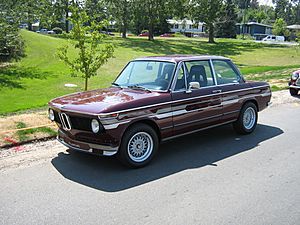
Germany is known for industrial design. Ferdinand Porsche and his family played a big part in German car design. Mercedes Benz cars focused on luxury and good looks. After the 1980s, German design became very distinct. It often matched their well-engineered cars, which were perfect for fast roads like the Autobahns.
Early German designs were influenced by Italian designers like Giovanni Michelotti and Giorgetto Giugiaro. German designs became very popular after the 1980s, especially with Audi. Volkswagen also developed its modern design style. BMW started with sporty sedans designed by Giovanni Michelotti. Later, designer Chris Bangle helped redefine BMW's look in the late 1990s.
Italy
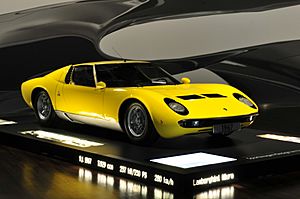
In Italy, companies like Fiat and Alfa Romeo were very important for car design. Many coachbuilders (companies that built car bodies) worked with these big manufacturers. Italy also had many sports car makers like Ferrari and Lamborghini.
In the late 1950s, Italian car designs became popular worldwide. Many design schools in Turin trained lots of designers. By the late 1960s, most Italian coachbuilders became design studios. They created designs for carmakers all over the world, including Japanese and Korean companies in the 1990s. Pininfarina is a famous example.
Well-known Italian designers include Giovanni Michelotti, Marcello Gandini, and Giorgetto Giugiaro.
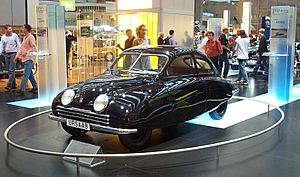
Sweden had carmakers like Volvo and Saab. Because of the cold weather, their cars needed to be tough. Scandinavian design is known for being simple and clean. An early example of this was the Saab 92001 car.
Czechoslovakia
Before World War II, Czechoslovakia had a strong car industry with brands like Skoda and Tatra. Czech cars were known for being simple and original in their design. During the Communist era, car design fell behind. Later, many Czech car companies became part of larger European companies.
See also
 In Spanish: Diseño de automóviles para niños
In Spanish: Diseño de automóviles para niños
- Automotive aerodynamics
- Industrial Design
- Automotive Engineering
- Alternative propulsion
- Automobile layout
- Computer-aided industrial design
- Automotive design terminology
- Coachbuilder
- Car body style
- Car classification
- Car model
- Car safety
- Cab forward
- Concept vehicle
- Dashtop mobile
- List of automotive designers
- Ecodesign
- Facelift (automobile)
- Virtual tuning
- H-point
- Mass production
- Packages
- Platform
- Ponton styling
- Pre-production car
- Prototype
- Solid freeform fabrication
- Three-box design
- Wind tunnel


